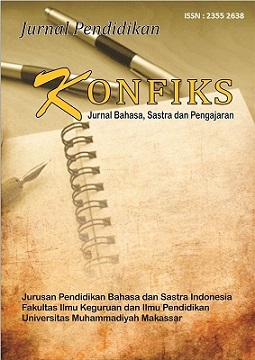NADIEM MAKARIM'S IDEOLOGICAL SYMBOLIC BATTLE DOMINATION: NORMAN FAIRCLOUGH'S CRITICAL DISCOURSE ANALYSIS
DOI: https://doi.org/10.26618/konfiks.v9i2.9128
linguistic discourse mode, symbolic battle, Norman Fairclough, lexical processs
Abstrak
This research was conducted to determine the lingual features of vocabulary description aspects and modes of linguistic discourse in the form of symbolic violence using language based on Norman Fairclough's critical discourse analysis contained in Nadiem Makarim's ideology on Instagram Live Prilly Latuconsina with Mendikbud, Research and Technology - Nadiem Makarim March 31, 2022. The approach used is a descriptive-qualitative approach. The data used are in the form of text transcription excerpts from dialogical video recordings using data collection techniques, note-taking techniques, free-of-conversation listening techniques, and recording techniques. This study uses three stages of data analysis techniques, including (1) data reduction; (2) presenting data; (3) drawing conclusions and verifying data. This study resulted in: (1) The lexical process occurred in the words "Mas Minister", "Dana Indonesiana" and "Kurikulum Merdeka"; (2) The symbolic struggle of the three words appears in the form of power in officially recognized names (labelling), monopoly of vision, coercion of views and actions, and perception control; (3) The mode of linguistic discourse of the three words includes dogmatic-aggressive persuasion and the degree of power of persuasion, the word "mas minister" appears 36 times, the word "dana" appears 22 times which represents an enduring budget fund named "Dana Indonesiana", the word "curriculum" appears 10 times, the word "merdeka" appears 11 times, these words have given rise to four lexical symbolic battles that contain experiential meanings and contain the meaning of terms that have the potential to have a single meaning with an aggressive-dogmatic pattern and have a degree of power. persuasion in the use of words.
Referensi
Arifianti, I. (2018). Conventional and Non Conventional implications. PENA, 32, 44–52. https://jurnal.unikal.ac.id/index.php/pena/article/view/936/697
Fairclough, N. (2013). Language and Power Second edition. In Routledge 2 Park Square, Milton Park, Abingdon, Oxon OX14 4RN 711 Third Avenue, New York, NY, 10017, USA (second). Routledge, Taylor & Francis 1989, 2001.
Hasanah, A., & Mardikantoro, H. B. (2017). Konstruksi Realitas Seratus Hari Pertama Pemerintahan Jokowi-Jusuf Kalla di Media Online: Analisis Wacana Kritis Model Norman Fairclough Alif. Seloka : Jurnal Pendidikan Bahasa Dan Sastra Indonesia, 3, 233–243. http://journal.unnes.ac.id/sju/index.php/seloka
Hasibuan, I. A., & Khairani, A. I. (2021). HEGEMONI BAHASA MILENEALISASI PADA SLOGAN DEMONSTRASI: ANALISIS WACANA KRITIS. KONFIKS JURNAL BAHASA DAN SASTRA INDONESIA, 7(2), 9–16. https://doi.org/10.26618/konfiks.v7i2.4294
Hendrajati, E. (2009). MODE WACANA BAHASA KEKUASAAN. Jurnal Sosial Humaniora, 2(1), 55–65. https://doi.org/10.12962/j24433527.v2i1.665
Jafar, K. (2015). Pada Cerita Wandiudiu. Linguistika: Buletin Ilmiah Program Magister Linguistik Universitas Udayana, 22, 154–161. https://ojs.unud.ac.id/index.php/linguistika/article/view/14004
Karnanta, K. Y. (2013). PARADIGMA TEORI ARENA PRODUKSI KULTURAL SASTRA: KAJIAN TERHADAP PEMIKIRAN PIERRE BOURDIEU. Jurnal Poetika, 1(1), 3–15.
Kuntarto, E. (2018). BAHASA DAN KEKUASAAN POLITIK OPOSAN DI INDONESIA: ANALISIS Wacana KRITIS. Jurnal Kiprah, 6(2), 37–47. https://doi.org/10.31629/kiprah.v6i2.860
Mubaligh, A. (2011). RELASI BAHASA DAN IDEOLOGI. LiNGUA: Jurnal Ilmu Bahasa Dan Sastra, 5(2), 112–118. https://doi.org/10.18860/ling.v5i2.622
Perdana, D. I. (2016). Kurikulum Dan Pendidikan Di Indonesia Proses Mencari Arah Pendidikan Yang Ideal Di Indonesia atau Hegemoni Kepentingan Penguasa Semata? Jurnal Pemikiran Sosiologi, 2(1), 63. https://doi.org/10.22146/jps.v2i1.23412
Santoso, A. (2019). Panorama Studi Wacana Kritis: Relasi antara Wacana Publik, Ideologi, & Kesadaran Berbahasa Kritis. Universitas Negeri Malang.
Sofyan, N. (2014). Bahasa Sebagai Simbolisasi Mempertahankan Kekuasaan. INTERAKSI: Jurnal Ilmu Komunikasi, 3(1), 75–84. https://doi.org/https://doi.org/10.14710/interaksi.3.1.75-84
Sukriyah, S., Sumarlam, S., & Djatmika, D. (2018). KOHESI LEKSIKAL SINONIMI, ANTONIMI, DAN REPETISI PADA RUBRIK CERITA ANAK, CERITA REMAJA, DAN CERITA DEWASA DALAM SURAT KABAR HARIAN KOMPAS. Aksara, 30(2), 267. https://doi.org/10.29255/aksara.v30i2.230.267-283
Tambunan, P. (2022). ANALISIS WACAN KRITIS NORMAN FAIRCLOUGH DALAM TALK SHOW MATA NAJWA “KONTROVERSI MAS MENTERI” [Universitas Diponegoro]. http://eprints.undip.ac.id/83934/1/Jurnal_Patricia.pdf
Wahyuni, S., Supratno, H., & Kamidjan, K. (2019). KEKERASAN SIMBOLIK DALAM NOVEL INDONESIA. RETORIKA: Jurnal Bahasa, Sastra, Dan Pengajarannya, 12(2), 128. https://doi.org/10.26858/retorika.v12i2.8833
Winarsih, S. (2013). Representasi Bahasa dalam Pertarungan Simbolik dan Kekuasaan. In Jurnal Bahasa Lingua Scientia (Vol. 5, pp. 11–24). http://download.garuda.kemdikbud.go.id/article.php?article=1238156&val=12545&title=REPRESENTASI BAHASA DALAM PERTARUNGAN SIMBOLIK DAN KEKUASAAN
Zaim, M. (2014). Metode Penelitian Bahasa: Pendekatan Struktural. Metode Penelitian Bahasa: Pendekatan Struktural, 1–123. http://repository.unp.ac.id/id/eprint/1830
Unduhan
Diterbitkan
Terbitan
Bagian
Lisensi
Authors who publish with this journal agree to the following terms:
The author owns the copyright and grants the journal rights for first publication with the work simultaneously licensed under a Creative Commons Attribution License which allows others to share the work with acknowledgment of the work's authorship and initial publication in this journal.
Authors may enter into separate additional contractual agreements for the non-exclusive distribution of the published journal version of the work (for example, posting it to an institutional repository or publishing it in a book), with acknowledgment of its initial publication in this journal.
Authors are permitted and encouraged to post their work online (for example, in institutional repositories or on their websites) before and during the submission process, as this can lead to productive exchanges, as well as earlier and larger citations of published work (See The Effect of Open Access).
Statement of Authenticity and Manuscript Copyright can be downloaded: Here
After filling in the statement letter, please send via e-mail: konfiks@unismuh.ac.id





.png)


